Our neighbor, Ken, was relaxing on his sofa recently when a monkey opened his sliding screen door and walked in.
I once read a Dean Koontz horror novel that began exactly like that, and by the end of it things had not gone well, so I would have been feeling some trepidation, but Ken is a special effects guy and used to make movie monsters for a living, so I guess he’s pretty hard to rattle.
The monkey walked across the floor toward him, and since she was a spider monkey (Ateles Geoffroyi), this was an odd-looking sight. Spider monkeys have limbs so long that their hands almost brush the ground as they walk, and they also have a prehensile tail almost three feet long, so when they walk, they do not balance with their arms like other monkeys, they use their tail, swinging it back and forth in great arcs while their arms hang at their sides. Ken watched her approach like this, and she came right up to him, jumped up on the sofa where he was sitting, climbed into his lap and wrapped both arms, both legs and her tail around him, and that was pretty much where she stayed for the next four days as this remarkable yarn played out.
I have to say that for a guy who has created monsters who have destroyed more than one world, Ken is an extremely kind-hearted guy. He recognized immediately that he was looking at a very sad story. This monkey snoozing in his lap was not wild. And he’d actually met her before, at a neighbor’s house. She obviously was accustomed to people, not monkeys, and he noticed that her canine teeth had been removed, leaving her defenseless. This was a dumped pet. She was wandering the jungle all alone, hungry and clueless, and gravitating toward human habitations.
I have held a spider monkey, and I can tell you that when a spider monkey embraces you, you know you’re being embraced. It’s a strange sensation—their appendages are just so long, and so—well, numerous. They wrap around you every which way, and that tail turns up in the oddest places. They’re difficult creatures to put down, and Ken was discovering that when a spider monkey decides she likes you, you’re in a bit of a spot. She was attached to him everywhere he went—meals, bed, even the bathroom. She wouldn’t let go. Ken had been adopted.
The wondrous little creature was easy to fall in love with, but she was warm and loving only so long as she was getting her way, and she quickly started becoming a handful. He tried to put her out a couple of times, but she would start destroying his screens from the outside. If she didn’t get her way inside the house, she’d go in the kitchen and start breaking dishes. If he intervened he’d get slapped. Ken had a situation on his hands. He was getting his heart stolen and his kitchen remodeled at the same time.
He was making phone calls and firing off emails, and several neighbors were involved by now, trying to work out a solution for this poor monkey. The good news ended up being that there is a monkey rescue center in the Yucatan. It’s called The Jungle Place, and it was founded by a saintly couple named Heidi and Joel, who thought they were coming down here to retire. (You can read their story here.) The monkey is now lovingly cared for and carefully supervised as she learns how to associate with other monkeys instead of people, in a large complex of enclosures near Chemuyil.
Susan and I see spider monkeys around here so commonly that it’s easy to forget how blessed we are to have them around. They are the most endangered primate in the Americas (there’s another species of spider monkey in South America that is doing better). There are five subspecies of these spider monkeys (ours is the Yucatan spider monkey, ateles Geoffroyi yucatanensis), and no one has firm numbers on them all, but they’re getting pretty scarce. They need healthy, tall tropical forest and they need a lot of it. One group might need as much as a thousand acres, and they don’t like people. And they shouldn’t. They are hunted for food by some and captured for the pet trade by others, and anyone who’s not doing one of those two things might be wiping out their forest to build a resort. As the jungles get more and more fragmented by developments, their numbers are nose diving. But we have them here. And since here is a gated community of five-acre properties where we are forbidden by our own bylaws to clear more than five percent of our land, I’m hopeful that these monkeys will continue to find sanctuary among us.
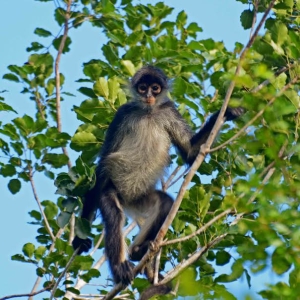
-
A Yucatan spider monkey (ateles geoffroyi yucatanensis) poses in a poisonwood tree. Photo by Jim Fossheim
I used to worry that our fairly modest dirt roads might impede their travels, but that was before I stood in the middle of one with my jaw on my chest as a monkey sailed across it, silhouetted against the sky, a hundred feet above me. It was like the road wasn’t even there. It was a display of confidence, faith, skill and beauty that you don’t very quickly forget. (Though I didn’t have a camera with me, our neighbor Jim is a little quicker on the uptake, and contributed the spectacular photo at the top of this article.) They spend a lot of time poking around in a lazy way, and during those periods they’ll be on the tops of the branches, but when they start to move in earnest they start swinging below them. Spider monkeys are second only to the gibbons in their mastery of this art. They can do forty horizontal feet in a single swing-and-leap. It’s a form of travel called brachiation, and it’s poetry to watch—a marriage of physics and five impossibly long limbs.
A group of spider monkeys can be as large as 100, though it is more commonly 20 to 30, but they are almost never seen all together. It’s a social structure called fission-fusion, and it’s pretty unusual. The main group breaks up into smaller sub-groups to go out foraging for the day, and if they don’t find much fruit, they will break up further to explore more possibilities. This keeps their demand on the fruit trees spread out across their huge territory, and reduces competition within the group. When fruit is plentiful, the subgroups will be larger. When it is not, they’ll be quite small, and you may even see solitary monkeys moving around. Even the sub-groups are fluid, and aren’t made up of the same individuals from one day to the next. The only associations with any persistence are between mother and child. And what’s really interesting about this fission-fusion social structure is that it is seen in only three primates: spider monkeys, chimpanzees—and us.
We often see a mother with a baby in the groups that cross our property. She carries the baby on her back, and they twine their tails together. Later on they will continue to travel together, and the mother will do things like pull two branches closer to each other to help the youngster make the leap. And they’re very human. They embrace after a period of separation, and they use gestures just like humans do. Our neighbor Tom saw a mother looking impatiently back at her child as the rest of the group was starting to move away. Finally, she reached back and thumped her own back, and the child obediently scampered up and climbed on board.
The subgroups are usually led by a female, who maps out the foraging route for the day. Sometimes a male will lead, but scientists say the females are better at it—they improvise more, and the troop ends up with a more varied diet. When Susan and I see them cross our property it is usually at the head of our driveway, and usually in a group of three or four (though as I was writing this, a group of seven or eight went by outside my window). They’re wonderful to watch, and we’ll stand there staring upward, but again, they don’t like people. When you bring one into focus in your binoculars, he’s invariably looking right at you. As he gets more agitated, he’ll start to bark like a dog. Finally, he’ll run out to the flimsy end of a branch and anchor himself by his tail while he uses all four limbs to vigorously shake the branches, and even throw some at you. (They are also known to pee and poop in your general direction, which is worth remembering.)
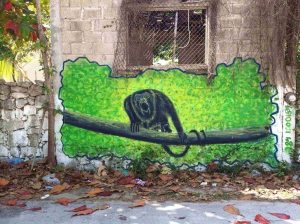
-
A remarkably accurate mural of a mantled howler monkey (Alouatta palliata) in Tulum. Photo by Randy Fry
They are among the most intelligent of the new world primates. They have twice the brain volume of the other prominent Central American monkey, which is the howler monkey. Scientists think they’re so smart because they are almost entirely fruit eaters (frugivores), so they rely on up to 150 species of trees and vines, and have to remember where they all are, and when they produce fruit.
And this whole old world versus new world thing is pretty interesting. When scientists say “new world primates,” they’re talking about the Americas. The “old world” primates in Africa and Asia, from whom we descended, are very different, and the differences open an interesting conversation about the evolutionary process. Old world and new world primates each have one key thing that the other doesn’t. In general:
Old world primates don’t have prehensile tails. This had always puzzled me, to be honest, because most of them are tree-dwelling creatures, at least in part, and we’re talking about an entire fifth limb, for heaven’s sake! It’s such a great innovation! I wish I’d invented it! It must confer a huge advantage! Why would it not evolve? Well, the difference lies in the forests. The forests in Central and South America are jungles, by the Webster definition—that is, they are extremely dense with very little open ground, lots of vines and climbing plants (they’re called liana), and a canopy that is completely unbroken. In these jungles, you can be entirely arboreal and never have to come to the ground unless you need something, like water. This is where spider monkeys live, and they stay high, way up in the upper canopy, and it’s why they look so funny when they try to walk. It’s just something that they never do, and aren’t built for.
Africa and Asia, by contrast, are teeming with large herbivores, which is something the Americas really don’t have. In the old world there are elephants, giraffes, and herds and herds of grazing animals, and they keep open areas in play. You may be a climber, but to live in this world, you also have to be able to get around on the ground. Tails can get in the way, and your climbing skills are less important. You have to be able to eat more than just fruit, too, and to do that, you have to compete on the savannas with some pretty fast and well-armed predators like lions and hyenas. This was what our ancestors faced. And the next paragraph has a lot to do with how we pulled it off:
New world monkeys don’t have opposable thumbs. Opposable thumbs make tool use possible, and tool use makes sophisticated cooperative hunting possible, and cooperative hunting makes it worthwhile for evolution to start increasing your intelligence, and that’s why you survived and are here today, and are able to read this article and think about these things. We are here because we outwitted the competition. Evolution didn’t give us intelligence for no reason. Intelligence is expensive. One fifth of our calorie intake goes to supporting our brains. Think about that—in a world where survival or extinction can turn on the slightest edge, that’s a huge chunk of our budget. Evolution doesn’t do such a thing unless there’s a payoff. The payoff was made possible by opposable thumbs. New world monkeys don’t have them, or, more accurately, they have lost them. They don’t need them and wouldn’t want them. They don’t need tools, because they have all the fruit they could ever want, and when you’re entirely arboreal, thumbs are in the way. You want your forelimbs to be nothing more than giant hooks. Thumbs might mess up those spectacularly beautiful leaps—and you don’t have to blow very many of those to remove yourself from the gene pool.
So those are the monkeys that surround us down here—intelligent, social, breathtaking in motion, and way too human. And I’ll leave you with one piece of trivia that’s probably more racy than you’re used to on this website. When you’re watching a group of spider monkeys pass by, the ones with the pink dangly things between their legs are not the males, they’re the females. I kid you not. The males’ penises retract completely and are seldom visible, but the females have the largest clitoris of any primate, and they’re always hanging out for everyone to see. They’re called hypertrophied, and they look for all the world like a penis—they even have a glans—but actually they’re only used for scent marking. As one Costa Rican rescue worker put it, human females have privates. Spider monkey females have publics.
Now you know.

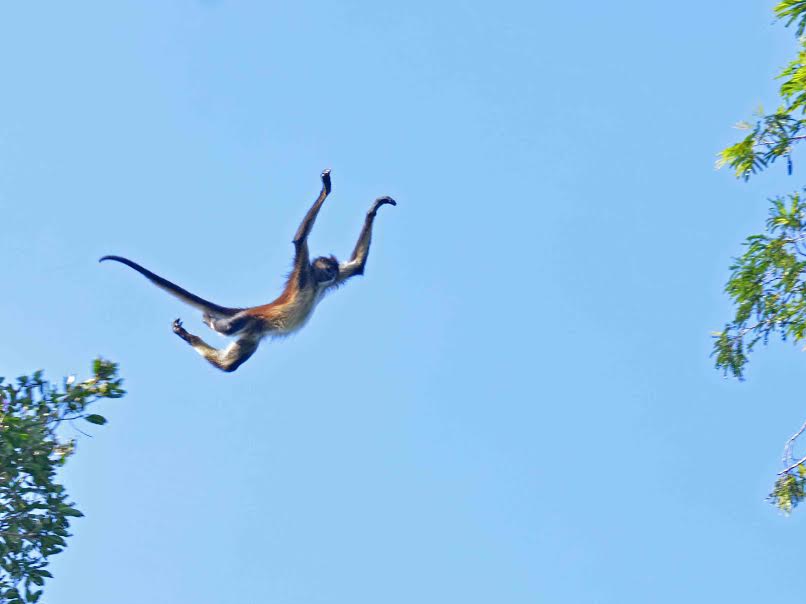
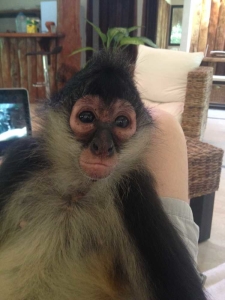
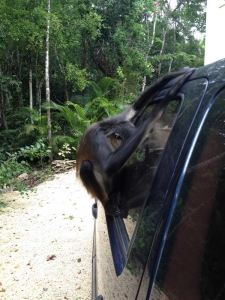
Randy, I found your website through the article you wrote for Akumal Now and thoroughly enjoyed this informative and well-written article! I was a fellow jungle dweller, spending 12 years just outside of Akumal. My adventures were similar and just as wild – there are still people around the bar in Akumal who remember my struggles with jaguars vs. rescued dogs…
Last year when I visited my land I was thrilled to see a pair of spiders, probably a male and female. Because of having so many dogs I’d never seen one on the land before but they were clearly back. This male acted just as you wrote, stretching himself to full length high in a tree and shaking branches vigorously. A real show.
I look forward to reading more of your posts!
Hey, Lucy, glad you enjoyed it! The monkeys have been a joy for us. (But don’t ever park your car under them.) Hey, rescue dogs vs. jaguars? Sounds like you have a few good yarns of your own!
Randy, I have been watching the Spiders in the area for many years It is so nice to know so much more about them. I have been worried about them having to move further into the Jungle as they did here at LSM I hope they manage to co exist with you all. Lou
Thanks, Lou! I sure hope we can co-exist with them. We should make every effort to.
Randy: Found the article this morning. Very good read. I did not know about the thumbs. Now that I can consider some of the leaps and plunges, thumbs would definitely not be an asset. I did not know how endangered they are. Aline and I were walking the dog along the road a week age and saw a very good sight. There was a troop of about ten monkeys with three females with little little babies on their backs. Did I mention they were little, yes very little. This is encouraging for their continued existence in LAT. And our enjoyment as well. Thank you for the work on this planet. Best Thomas.
Thanks, Tomas! Yes, we see babies often too, and that does give me hope. As far as their endangered status, numbers are very hard to come by. That figure of 2,000 monkeys was the ONLY figure I was able to find (MacAlester College, Minnesota), so I hope it’s not off. Anyway, let’s let the tall trees live here in Los Arboles and hope for the best!
Amazing! I never thought I’d ever know this much about spider monkey sexuality. Thanks for sharing…
Thanks, Marty! Nothing but the best in R-rated science!
Great googly mooglies mon Breaux, you’ve done it again!
This article is brilliant, funny, cute, engaging and of course very informative…but most importantly, it manages to give the reader a good grasp on the big picture of what we are and how we came to be. And I did not know that about “Old World” and “New World” primates, and only our new jungle-dwellers having prehensile tails. I too had noticed that about some primates and wondered why, and as you say…now I know.
Thanks!
Thanks, By! Hope you’re making brilliant music!
What a terrific read! So appreciate your ability to connect personal interaction with nature and scientific knowledge about your subject. Thanks for sharing!
Thanks so much, Michele! Great to hear your voice!